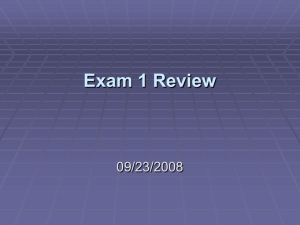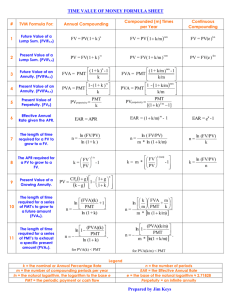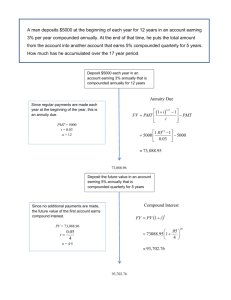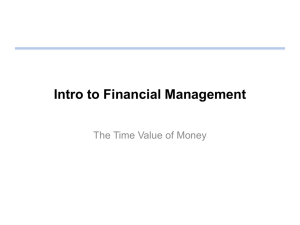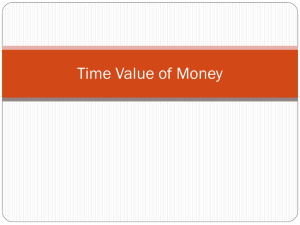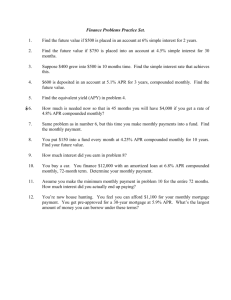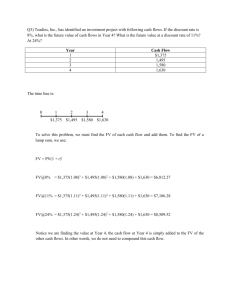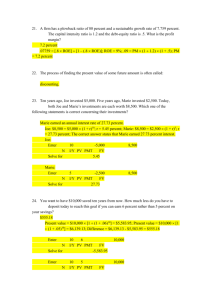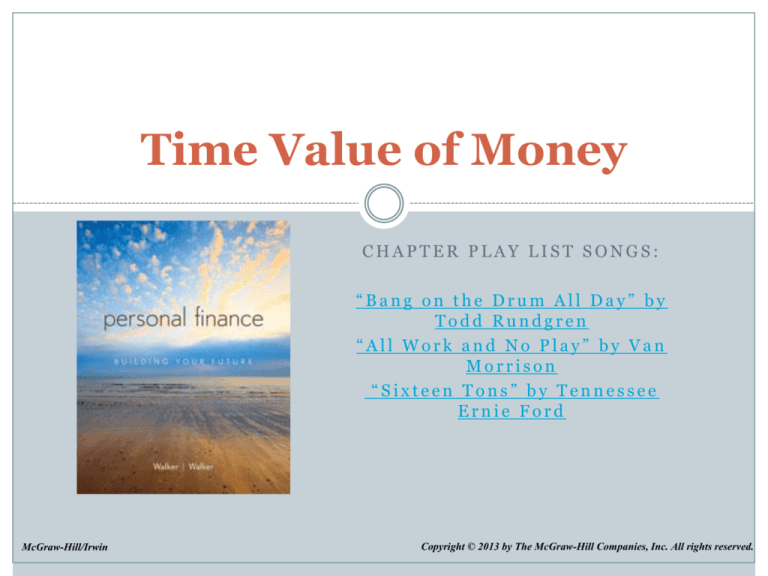
Time Value of Money
CHAPTER PLAY LIST SONGS:
“Bang on the Drum All Day” by
Todd Rundgren
“All Work and No Play” by Van
Morrison
“Sixteen Tons” by Tennessee
Ernie Ford
McGraw-Hill/Irwin
Copyright © 2013 by The McGraw-Hill Companies, Inc. All rights reserved.
Learning Objectives
LO 2-1 Explain what gives paper currency value and
how the Federal Reserve Banks manage its
distribution.
LO 2-2 Differentiate between simple and compound
interest rates and calculate annual
percentage yields and the value of paying
yourself first.
LO 2-3 Calculate the future and present value of
lump sums and annuities in order to know
what to put aside to meet your personal
financial goals.
2-2
Money Production
Money is produced by our Government
Cash is produced by the Bureau of Engraving & Printing in D.C.
and Fort Worth
Coins are produced by the US mint in Philadelphia and Denver
Money is then sent to the Federal Reserve banks.
2-3
Power of Compounding
“The most powerful force in the universe is compound
interest” ~ Albert Einstein
If Ben Franklin deposited $20 for you 250 years ago, what
would its value be at 5%, 8% and 10% interest rates?
2-4
Compounding Interest
Compounding: Process whereby the value of an
investment increases exponentially over time due to
earning interest on interest previously earned
Annual Percentage Rate (APR): Annual rate
charged for borrowing or made by investing
Annual Percentage Yield (APY): Effective yearly
rate of return taking into account the effect of
compounding interest
2-5
Simple Interest vs. Compound Interest
Simple Interest on $1,000 @12%
Deposit of $1,000 on Jan. 1…
$1,000 + (1,000 x .12) = $1,120 Resulting balance on Dec. 31
Compound Interest Quarterly on $1,000 @12%
12% ÷ 4 time periods = 3% per quarter
Deposit of $1,000 on Jan. 1…
$1,000.00 + (1,000.00 x .03) = $1,030.00
$1,030.00 + (1,030.00 x .03) = $1.060.90
$1,060.90 + (1,060.90 x .03) = $1,092.73
$1,092.73 + (1,092.73 x .03) = $1,125.51 Resulting balance on Dec. 31
2-6
Annual Percentage Yield (APY)
Compound Interest Quarterly on $1,000 @12%
12% ÷ 4 time periods = 3% per quarter
Deposit of $1,000 on Jan. 1…
$1,000.00 + (1,000.00 x .03) = 1,000.00 + 30.00 = $1,030.00
$1,030.00 + (1,030.00 x .03) = 1,030.00 + 30.90 = $1,060.90
$1,060.90 + (1,060.90 x .03) = 1,060.90 + 31.83 = $1,092.73
$1,092.73 + (1,092.73 x .03) = 1,092.73 + 32.78 = $1,125.51
Resulting interest yield Dec. 31...
30.00 + 30.90 + 31.83 + 32.78 = $125.51 Annual Yield
125.51/1,000 = 12.55% APY
2-7
Annual Percentage Yield (APY)
APY = (1 + r/n)n – 1
r = stated annual interest rate
n = number of times compounded/year
2-8
APY Examples
The 12% rate compounded
annually yields (1 + .12/1)1 – 1
= 12.00%
semiannually yields (1 + .12/2)2 – 1 = 12.36%
quarterly yields (1 + .12/4)4 – 1
= 12.55%
monthly yields (1 + .12/12)12 – 1
= 12.68%
daily yields (1 + .12/365)365 – 1
= 12.75%
2-9
Lottery Winner???
If you won the lottery would it be better to take the
cash option now or choose to receive the amount in
payments over your expected lifetime?
2-10
Time Value of Money
A dollar now is worth more than a dollar in the
future, even after adjusting for inflation, because a
dollar now can earn interest or other appreciation
until the time the dollar in the future would be
received.
2-11
Time Value of Money Example
Age
19
20
21
22
23
24
25
26
27
28
29
30
31
Smart Sam
$2,000.00
$4,200.00
$6,620.00
$9,282.00
$12,210.20
$15,431.22
$18,974.34
$22,871.78
$27,158.95
$31,874.85
$35,062.33
$38,568.57
$42,425.42
Amount
Deposited
Wild Willie
$2,000.00
$2,000.00
$2,000.00
$2,000.00
$2,000.00
$2,000.00
$2,000.00
$2,000.00
$2,000.00
$2,000.00
$2,000.00
$4,200.00
$6,620.00
Amount
Deposited
Dedicated Dave
$2,000.00
$4,200.00
$6,620.00
$9,282.00
$12,210.20
$15,431.22
$18,974.34
$22,871.78
$27,158.95
$31,874.85
$2,000.00
$37,062.33
$2,000.00
$42,768.57
$2,000.00
$49,045.42
Amount
Deposited
$2,000.00
$2,000.00
$2,000.00
$2,000.00
$2,000.00
$2,000.00
$2,000.00
$2,000.00
$2,000.00
$2,000.00
$2,000.00
$2,000.00
$2,000.00
2-12
Time Value of Money Example (continued)
60
61
62
63
64
65
66
67
68
69
$672,998.45
$740,298.29
$814,328.12
$895,760.94
$985,337.03
$1,083,870.73
$1,192,257.81
$1,311,483.59
$1,442,631.95
$1,586,895.14
$402,275.53
$444,503.09
$490,953.40
$542,048.74
$598,253.61
$660,078.97
$728,086.87
$802,895.56
$885,185.11
$975,703.62
$2,000.00
$2,000.00
$2,000.00
$2,000.00
$2,000.00
$2,000.00
$2,000.00
$2,000.00
$2,000.00
$2,000.00
$1,075,273.98
$1,184,801.38
$1,305,281.52
$1,437,809.67
$1,583,590.64
$1,743,949.71
$1,920,344.68
$2,114,379.14
$2,327,817.06
$2,562,598.76
$2,000.00
$2,000.00
$2,000.00
$2,000.00
$2,000.00
$2,000.00
$2,000.00
$2,000.00
$2,000.00
$2,000.00
70
$1,745,584.65
Amount Invested
at 10%
$1,075,273.98
$2,000.00
$2,820,858.64
$2,000.00
$20,000.00
$84,000.00
$104,000.00
2-13
FYI
Saving $2000 per year is only $166.67 per month or
$38.46 per week or $5.48 per day.
A pack a day smoker spends $49 dollars a week,
$208 dollars a month, and $2,548 a year
The average coffee drinker spends $1,100 per year
What could you give up today so you could have a
million dollars in the future?
2-14
Secrets to Making Compounding Work
Pay yourself first
Automatic transfer to savings and investment accounts
Transfer money on payday
Treat it like a bill
Start small
Increase the amount at least annually
Don’t touch the money
2-15
Time Value of Money
Future Value: The projected value of an asset
based on the interest rate and time in the account
Present Value: The current value of an asset to be
received in the future based on the interest rate and
time in the account
Lump Sum: A single, one-time payment
Annuity: A series of equal payments made at equal
intervals over time (day, month, year)
2-16
Future Value (FV), Long-Hand Method
FV = PV (1 + i)n where
FV = Future value
PV = Present value
i
= Interest rate
n = Number of periods
2-17
Problem
At the time of your birth your aunt deposited
$10,000 for you into an account earning 5%
annually. How much money will you have on your
18th birthday? How much money will you have when
you turn 30? How much money will you have by the
time you retire at age 65?
2-18
Future Value (FV), Long-hand Method Example:
$10,000 at Birth, Earning 5% Annually, Age 18
FV = PV (1 + i)n
FV = $10,000 (1 + 0.05)18
FV = $10,000 (1.05) 18
FV = $10,000 (2.41)
FV = $24,066.19 on your 18th birthday
2-19
Future Value (FV), Long-hand Method Example:
$10,000 at Birth, Earning 5% Annually, Age 30
FV = PV (1 + i)n
FV = $10,000 (1 + 0.05)30
FV = $10,000 (1.05)30
FV = $10,000 (4.32)
FV = $43,219.42 on your 30th birthday
2-20
Future Value (FV), Long-hand Method Example:
$10,000 at Birth, Earning 5% Annually, Age 65
FV = PV (1 + i)n
FV = $10,000 (1 + 0.05)65
FV = $10,000 (1.05)65
FV = $10,000 (23.84)
FV = $238,399.01 on your 65th birthday
2-21
Future Value Interest Factor (FVIF) Table Method
Future Value Interest Factor (FVIF): Factor multiplied by
today’s amount to determine value of said amount at a future
date
2-22
Future Value (FV), Reference Table Method Example:
$10,000 at Birth, Earning 5% Annually, Age 18
FV = PV (FVIFi,n)
FV = $10,000 (FVIF5,18)
FV = $10,000 (2.4066)
FV = $24,066.00 on your 18th birthday
2-23
Future Value (FV), Reference Table Method Example:
$10,000 at Birth, Earning 5% Annually, Age 30
FV = PV (FVIFi,n)
FV = $10,000 (FVIF5,30)
FV = $10,000 (4.3219)
FV = $43,219.00 on your 30th birthday
2-24
Present Value of a Lump Sum
Discounting: The reverse of compounding; finding
the present value of a future amount by deducting
the interest to be made
2-25
Present Value (PV), Long-Hand Method
PV = FV/(1 + i)n where
PV = Present value
FV = Future value
i
= Interest rate
n
= Number of time periods
2-26
Problem
You want your newborn to have $10,000 at age 18.
How much would have to be deposited, assuming a
6% interest rate compounded annually (simple
interest)?
2-27
Present Value (PV), Long-hand Method Example:
$10,000 in 18 Years, Earning 6% Annually
PV = FV (1 + i)n
PV = $10,000/(1 + 0.06)18
PV = $10,000/(1.06)18
PV = $10,000/(2.85)
PV = $3,503.44 to be deposited
2-28
Present Value Interest Factor (PVIF) Table Method
Present Value Interest Factor (PVIF): Factor multiplied
by a future amount so as to determine the value of said
amount today
2-29
Present Value (PV), Reference Table Method Example:
$10,000 in 18 Years, Earning 6% Annually
PV = FV (PVIFi,n)
PV = $10,000 (PVIF6,18)
PV = $10,000 (.3503)
PV = $3,503.00 to be deposited
2-30
Future Value of an Annuity
Ordinary Annuity: Stream of equal payments that
occurs at the end of a period
Annuity Due: Stream of equal payments that
occurs at the beginning of a period
2-31
Future Value of an Annuity (FVA),
Long-Hand Method
FVA = PMT {[(1 + i)n – 1]/i}
where
FVA = Future value of an annuity
PMT = Payment
i
= Interest rate
n
= Number of time periods
2-32
Problem
Your parents want to contribute to your child’s
education, but instead of a lump sum payment of
$3,500, they plan to contribute $500 each year for
18 years. How much money will your child have in
his or her educational fund after 18 years at 6%
interest?
2-33
Future Value of an Annuity (PVA), Long-hand Method Example:
$500 Payments for 18 years, Earning 6% Annually
FVA = $500{[(1 + 0.06)18 – 1]/0.06}
FVA = $500{[(1.06)18 – 1]/0.06}
FVA = $500[(2.85– 1)/0.06]
FVA = $500(1.85/0.06)
FVA = $500(30.91)
FVA = $15,452.83 funded
2-34
Future Value Interest Factor of an Annuity (FVIFA)
Future Value Interest Factor of an Annuity (FVIFA):
Factor multiplied by the annuity (payment) to determine the
amount in the account at a future date
2-35
Future Value of an Annuity (FVA), Reference Table Method Example:
$500 Payments for 18 Years, Earning 6% Annually
FVA = PMT x FVIFA i, n
FVA = $500 x 30.906
FVA = $15,453.00 funded
2-36
Calculating an Annuity Due
Solve for an ordinary annuity by using the formula
FVA = PMT {[(1 + i)n – 1]/i}, or the FVA table.
2. Multiply it by 1 plus the interest rate (1 + i) since
the payments come at the beginning of the period.
1.
FVAd = FVA(1 + i)
where
FVAd = Future value of an annuity due
FVA = Future value of an ordinary annuity
i
= Interest rate per period
2-37
Annuity Due from Previous Example
FVAd = FVA(1 + i)
FVAd = $15,453.00(1 + 0.06)
FVAd = $15,453.00(1.06)
FVAd = $16,308.18 funded
2-38
Present Value of an Annuity (PVA),
Long-Hand Method
PVA = PMT ({1 – [1/(1 + i)n]}/i)
where
PVA = Present value of annuity
PMT = Payment
i
= Interest rate per period
n
= Number of periods
2-39
Problem
You want to be able to retire at age 65 with an
income stream of $100,000 a year for the next 20
years. You think you will get a 5% return on your
money. How much money will you need to save
before you retire?
2-40
Present Value of an Annuity (PVA), Long-hand Method Example:
$100,000 Payment in 20 Years, Earning 5%
PVA = $100,000 ({1 – [1/(1 + 0.05)20]}/0.05)
PVA = $100,000 ({1 – [1/(1.05)20]}/0.05)
PVA = $100,000 {[1 - (1/2.65)]/0.05}
PVA = $100,000 [(1 - .38)/0.05]
PVA = $100,000 (.62/0.05)
PVA = $100,000 (12.46)
PVA = $1,246,221.03 needed in retirement savings
2-41
Present Value Interest Factor of an Annuity (PVIFA)
Present Value Interest Factor of an Annuity (PVIFA):
Factor multiplied by the annuity (payment) to determine the
value of the annuity today
2-42
Present Value of an Annuity (PVA), Reference Table Method Example:
$100,000 Payments in 20 Years, Earning 6%
PVA = PMT x PVIFA i, n
PVA = $100,000 x PVIFA 6, 20
PVA = $100,000 x 12.462
PVA = $1,246,200.00 needed in
retirement savings
2-43
Calculating Loan Payments
PVA = PMT ({1 – [1/(1 + i)n]}/i)
where
PVA = Present value of an ordinary annuity
PMT = Payment
i
= Interest rate per period
n
= Number of periods
2-44
Problem
If you are financing $15,000 at 6% interest for three
years, making annual payments, you know the
following:
PVA = 15,000
i
= .06
n
=3
2-45
Long-Hand Method
Annual Loan Payment Calculation
15,000 = PMT ({1 – [1/(1 + .06)3]}/.06)
15,000 = PMT {[1 – (1/1.063)]/.06}
15,000 = PMT {[1 – (1/1.19)]/.06}
15,000 = PMT [(1 – .84)/.06]
15,000 = PMT (.16/.06)
15,000 = PMT (2.67301)
Divide both sides by 2.67301 and your answer is:
$5,611.65 = PMT
2-46
Reference Table Method
Annual Loan Payment Calculation
PVA
= PMT (PVIFAi,n)
15,000
= PMT (2.673)
5,611.67 = PMT
2-47
Monthly Payments
To determine your monthly payments, divide your
interest rate by 12. Your number of payments is now
36. For the above example, we would have the
following:
PVA = 15,000
i
= .06/12 = 0.005
n
= 36
PMT = ?
2-48
Long-Hand Method
Monthly Loan Payment Calculation
Using the formula, your equation would be as follows
15,000 = PMT ({1 – [1/(1 + .005)36]}/.005)
15,000 = PMT {[1 – (1/1.005)36]/.005}
15,000 = PMT {[1 – (1/1.19668)]/.005}
15,000 = PMT [(1 –.84)/.005]
15,000 = PMT (.16/.005)
15,000 = PMT (32.8710)
456.33 = PMT
2-49
Reference Table Method
Monthly Loan Payment Calculation
Extrapolating, you would find PVIFA.5, 36 equals
32.871
PVA
= PMT (PVIFAi,n)
15,000 = PMT (32.871)
456.33 = PMT
2-50
Learn
LO 2-1 Explain what gives paper currency value and
how the Federal Reserve Banks manage its
distribution.
LO 2-2 Differentiate between simple and compound
interest rates and calculate annual
percentage yields and the value of paying
yourself first.
LO 2-3 Calculate the future and present value of
lump sums and annuities in order to know
what to put aside to meet your financial goals.
2-51
Plan & Act
Assess the cost of your goals from Chapter 1
(Worksheet 2.1).
Review your options for designating current savings
to a specific future goal and calculate how much
money you need to deposit annually to support that
long-term goal (Worksheet 2.2).
Calculate how much you need to set aside in savings
each your, starting now, to reach your retirement
goal (Worksheet 2.3).
Consider starting a ‘Dedicated Dave’ automatic
deposit account by putting $5 per day into savings.
2-52
Evaluate
Open the online GoalTracker after completing
Worksheet 2.1 and record the estimated costs and
savings plans of your SMART goals.
Assess how you are achieving your goals.
2-53
Continuing Case: Investment Options
Housemate
Goal
Leigh
Art teacher, works part-time at co-op for the discount, bikes to
work, is a vegetarian, gardens, has egg-laying backyard hens
Backpack through Europe for a
summer in 5 years
Blake
Junior, business student, expected to take on family business,
wants to work on Wall Street
Compete in Hawaiian Iron Man in
5 years
Nicole
Freshman, pre-nursing for the moment, somewhat spoiled
Graduate in 4 years
Karri
5th year student, Communications major; Loves shoes, high
fashion, chocolate, wine, and the Big Apple
Anchor the evening news for a local
television network
Peter
Sous chef, internship in Tokyo, would love someday to go back
and visit, wants to summit all the CO high peaks
Open his own sushi restaurant in 3
years
Brett
2nd year med student, focused on emergency medicine,
interested in volunteering for Doctors without Borders
Complete med school and
residency with little/no debt
Jen
Freshman, Community College, undecided major, very social,
fastest texter in high school graduating class
Pick a major, transfer to the
university after 2 years, graduate in
4 years
Jack
Newly graduated in General Studies, part-time bartender, in to
paintball
Not move back with parents and
decide on a career
2-54


